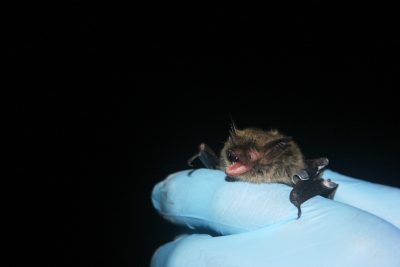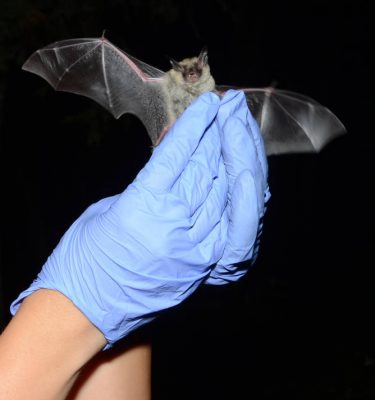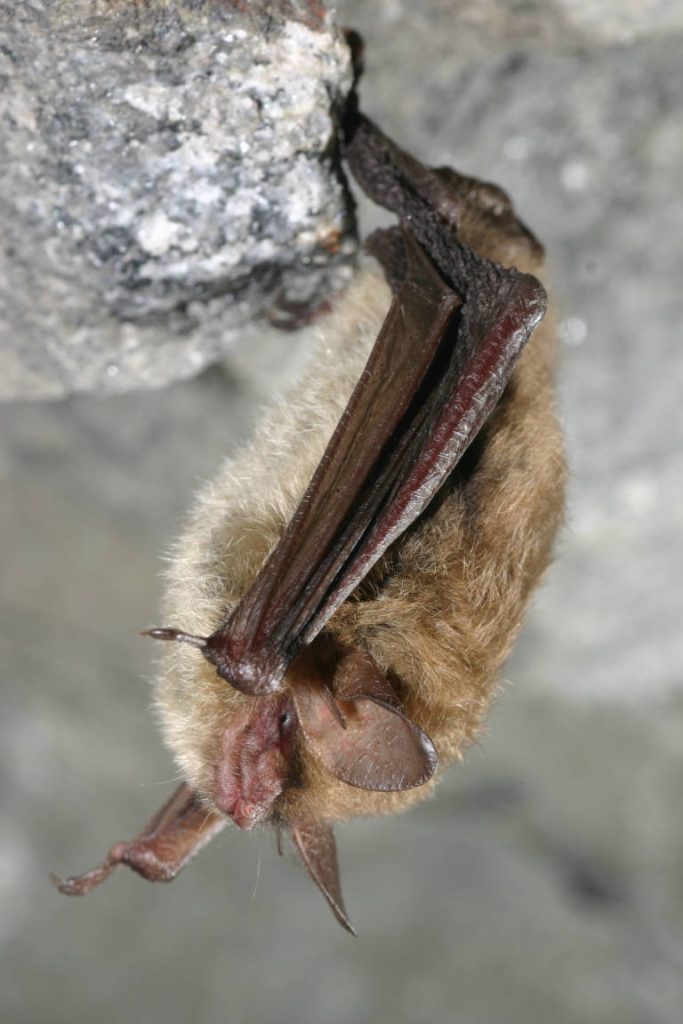By Megan Pettey
The U.S. Fish and Wildlife Service declared the northern long-eared bat federally endangered on Nov. 29 in an effort to save the species, whose population has sharply declined due to the fungal disease known as white-nose syndrome.
The northern long-eared bat is the most severely impacted of the 13 bat species affected by white-nose syndrome. The disease is identified by white fuzz found on the noses of hibernating bats, hence the name.
The fungus attacks bats while they’re inactive and can cause them to wake early during hibernation, at times triggering unusual behavior such as flying during the daytime. This increased activity starves bats by burning the fat needed to survive in the winter.
With no known cure, white-nose syndrome has killed millions of bats since it was first identified in 2006. The fast-spreading fungus thrives in the cold, humid conditions of caves and abandoned mines where hibernating bats rest during the winter. As of 2022, the disease has spread to 38 U.S. states and eight Canadian provinces, encompassing nearly the entire range where northern long-eared bats are found.
The disease has led to a northern long-eared bat population decline of 99% or greater in several of the Eastern states where they live.

Biologists catch and tag northern long-eared bats as part of on-going research for the U.S. Fish and Wildlife Service. Photo courtesy of the U.S. Fish and Wildlife Service.
Additionally, the tricolored bat is experiencing population decreases of 90% or more in colonies affected by the fungus, prompting a proposal from the U.S. Fish and Wildlife Service in September add tricolored bats to the endangered species list.
In addition to 39 U.S. states and four Canadian provinces, tricolored bats live in parts of Mexico, Guatemala, Honduras, Belize and Nicaragua. With a wider range than the northern long-eared bat, the decimation of tricolored bats as a result of white nose syndrome points to the widespread nature of the fungus and the grave threat this disease poses for the bat species as a whole.
Bats are integral to the health of ecosystems and contribute billions of dollars in value annually to the economy by pollinating plants and feeding on crop pests. According to the U.S. Fish and Wildlife Service, the increasing death rates in cave-dwelling bats shows the need forEndangered Species Act conservation efforts to save these essential mammals.
Far stronger protective measures exist for species classified as endangered compared to those listed as threatened. The Endangered Species Act prohibits the killing of listed species, with some exceptions, and requires the U.S. Fish and Wildlife Service to implement a protection plan that includes protection of the endangered species’ habitat. For the northern long-eared bat, this means more safeguards against logging, deforestation and mining that destroys the forested environments in which they live.
This increased protection is a primary reason why the nonprofit environmental organizations Center for Biological Diversity, Sierra Club, Coal River Mountain Watch, Defenders of Wildlife and Ohio Valley Environmental Coalition challenged the agency’s decision to list the northern long-eared bat as threatened in 2015. The groups alleged that the agency should have listed the bat as endangered rather than threatened, and in March 2021, a federal judge ordered the Fish and Wildlife Service to determine whether the species warranted an endangered listing.
Despite a clear, devastating decline in the species’ population, executive director of Coal River Mountain Watch Vernon Haltom states that the agency delayed the endangered listing due to the numerous industries that would be affected by increased protective measures.
“Various industries opposed it,” Haltom says. “You know, coal industries, oil industries, timber industries. Any industry whose operations would be impeded by the designation.”
Coal River Mountain in West Virginia is home to both the northern long-eared bat and the Indiana bat, which has been listed as endangered since the late 1960s. Protection plans in this area include a ban on timbering between April and October as bats roost in trees during the summer months.
“That does affect their operations; it does make it more costly when you can’t just go out and start mowing down trees and bulldozing trees anytime you want to,” Haltom says.
While environmental advocates consider the endangered designation a victory for the northern long-eared bat, Haltom fears it might be “too little too late.” Since timbering is still permitted between November 15 and March 31, bats come out of hibernation to find chunks of their forests depleted. Haltom claims stronger protections are necessary for preserving the species, such as banning blasting and deforestation in their habitat altogether.
Northern long-eared bats are central to the region’s ecology as their nutrient-rich droppings replenish Appalachian topsoil, which is thin and takes a while to build up, according to Haltom. Bats also feed on mosquitoes, which the U.S. Centers for Disease Control and Prevention considers to be the world’s deadliest animal.

This northern long-eared bat was caught and released during the 2013 Bat Blitz in Oklahoma. Photo courtesy of the U.S. Fish and Wildlife Service.
“I think any species needs to be allowed to exist in its own right,” Haltom says. “It’s a living thing. You know, everything’s tied together and you eliminate one species and other dominoes start to fall from that. In the case of the northern long-eared bat we often hear, ‘Well, what good is this for people?’ Well, they eat mosquitoes, and I’d rather have bats in my neighborhood than the West Nile virus.”
Haltom adds the northern long-eared bat likely benefits the region in other ways that humans aren’t aware of, and the unintended consequences of their extinction would be profound.
“Basically the northern long-eared bat is hanging on by a thread and we need to do what we can to strengthen that thread, give them a rope,” Haltom says.
Northern Long-Eared Bats Fun Facts
- Northern long-eared bats have an average length of about 7.8 centimeters and generally weigh between 6-9 grams. Female bats are typically slightly larger than their male counterparts.
- Unsurprisingly, these bats can be distinguished from other species of the bat genus Myotis by their much longer ears.Northern long-eared bats are found in mature, interior forests in 37 states across the eastern and north central United States. This species is also found in all Canadian provinces.
- In the summer, long-eared bats roost in tree cavities or under loose bark either by themselves or in small groups. During the winter, the bats hibernate in caves and abandoned mines, preferring tight crevices to open spaces.
- The average lifespan of the northern long-eared bat is estimated between 18 and 19 years.
- Similarly to other bats, long-eared bats mate in the fall prior to hibernation. However, females don’t become pregnant until they wake from hibernation due to delayed fertilization.
- After hibernation, pregnant females roost in small colonies to give birth to single pups sometime between late May and early July. The colonies range between 30 and 60 bats, consisting of both mothers and their young.
- Northern long-eared bats primarily eat moths but also feed on other insects such as beetles, flies, leafhoppers, mosquitoes and caddisflies.
- Rather than catching their prey in flight, long-eared bats snatch up their prey directly from the surface.
Related Articles
Latest News

Leave a comment
Your email address will not be published. Required fields are marked *






I wish we did not have to worry about these small creatures BUT
somehow we humans most likely carried problem from most likely Europe’s caves to our caves where our bats did not have the immunity to fight the fungal disease. We, humans, are inventive
surely we can find a way not force to extinction these valuable
insect eaters. Surely we can harvest forest better, we have to adapt as well. I think W.VA should allow rehab of bats. Rehabbers are also educators & some researchers as well.